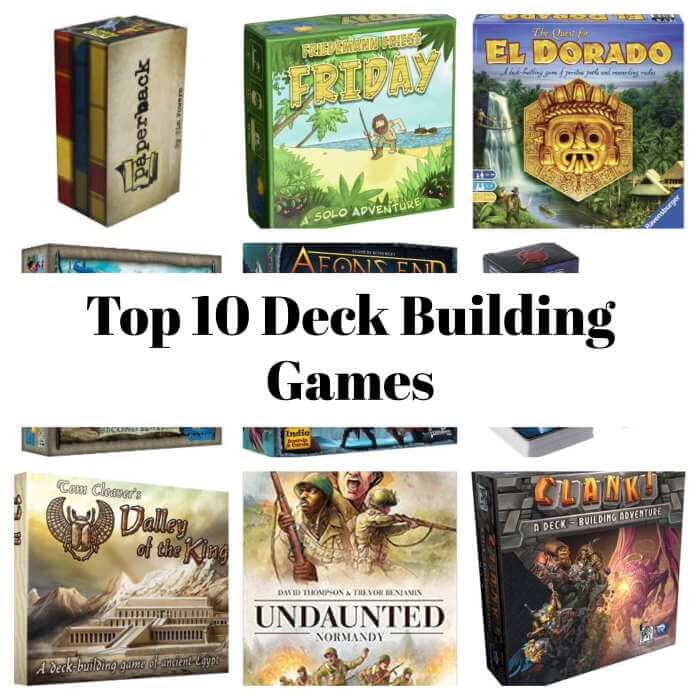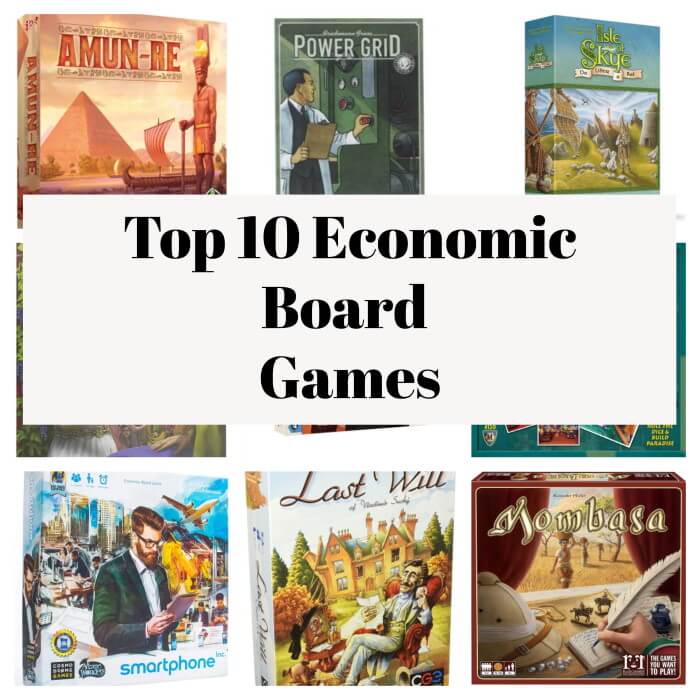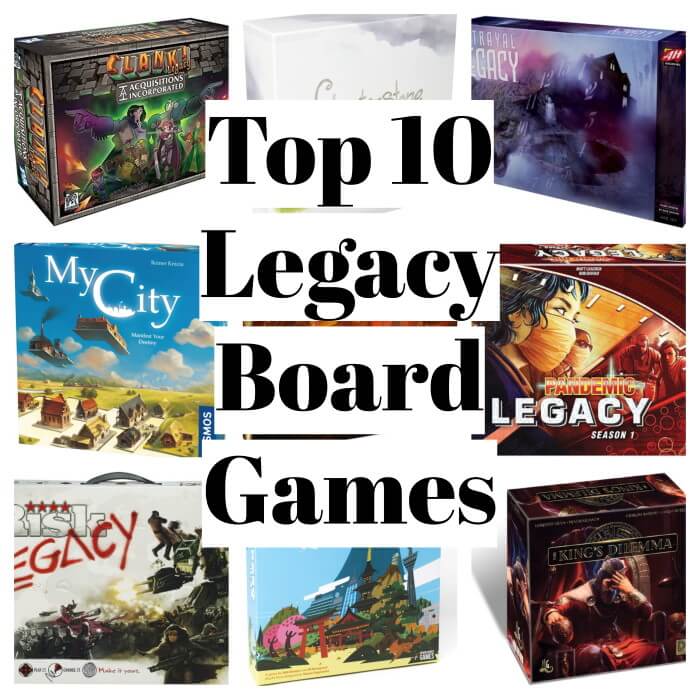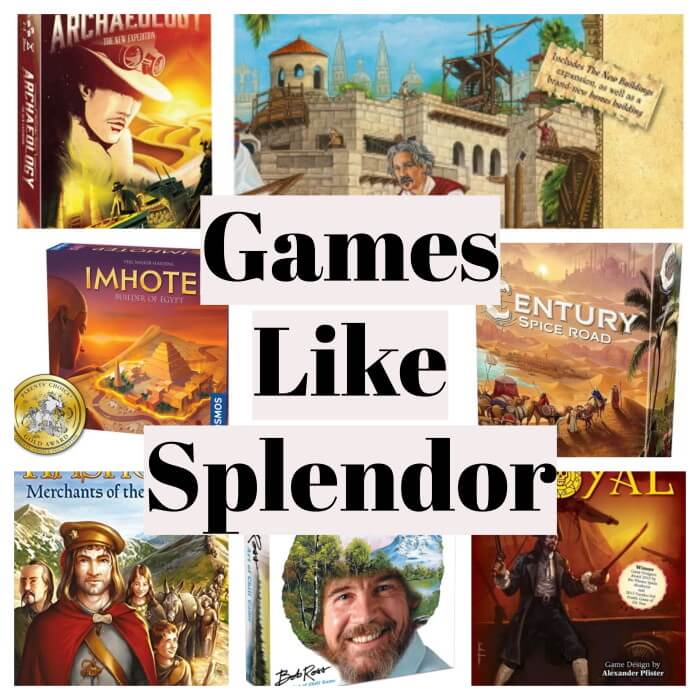
When Splendor was released in 2014, this game all about collecting gems, purchasing cards, attracting nobles, and racing to 15 points quickly became massively popular in the board gaming community and was nominated for the Spiel des Jahres award that same year.
Despite the fact that Splendor often gets criticized for having very little theme, there’s no doubt that it’s a game that gamers keep coming back to and remains a staple in many people’s collections.
And while there are certainly many things to like about the game Splendor, perhaps what hooks people in the most are its lightning-quick turns and gameplay, ease of learning and teaching, a sense of progression in a short amount of time, and yes – those gem poker chips that are so satisfying to hold.
Splendor at a Glance
| Game Type Card Game, Economic, Renaissance, Card Drafting, Turn-Based, Resource Management | Play Time 30 mins | Skill/Complexity (2 - 5) Light - Medium |
| Age 10+ | Publisher(s) Space Cowboys and others | Published 2014 |
| Categories Family | Players 2 - 4 | Cost $30 - $40 |
| Our Rating 9/10 |
Whatever your reason is for loving Splendor, here are 10 games that have a similar feel to Splendor in one way or another but offer new kinds of experiences you are very likely to enjoy.
1. Century: Spice Road – The Game Most Like Splendor
Perhaps the game that Splendor most often gets compared to the most is Century: Spice Road, designed by Emerson Matsuuchi, so it absolutely deserves to be included on this list. But while the two games are similar in many ways, they are both great games in their own regard and can both have a place in a gamer’s collection.
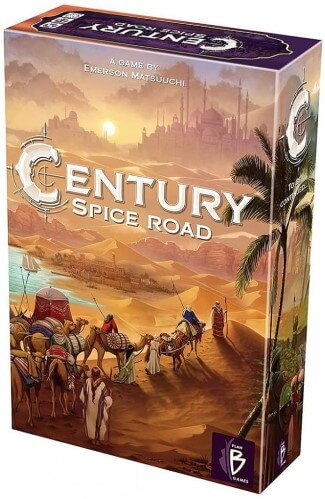
Century: Spice Road at a Glance
| Game Type Medieval Theme, Card Game, Economic, Action Retrieval, Card Drafting, Contracts, Deck Building, Hand Management, Set Collection | Play Time 30 - 45 mins | Skill/Complexity (2 - 5) Light - Medium |
| Age 8+ | Publisher(s) Plan B Games and Others | Published 2017 |
| Categories Family / Strategy | Players 2 - 5 | Cost $39.99 approx. |
| Our Rating 9/10 |
In Century: Spice Road, players are attempting to be the best spice trader by acquiring the most points at the end of the game, which is triggered once a player has gained their 5th victory point card. These victory point cards are the sole way of gaining points in the game, and can be acquired on a player’s turn by discarding the required spices as indicated on the card.
Like Splendor, Century: Spice Road is heavily focused on gathering resources of certain colors, and trading those colors to buy cards which can help you perform better actions. Players use cards from their hand to perform actions, like gathering spices of certain colors or upgrading spices. They can also buy a new card from the available display; the left-most card is free, but players can buy any card by placing a spice cube on each card to the left of that card. Lastly, players can rest on their turn, and retrieve all their cards back into their hand.
Like Splendor, Century: Spice Road is heavily focused on gathering resources of certain colors, and trading those colors to buy cards which can help you perform better actions.
One aspect that makes Century: Spice Road different from Splendor is the use of cards in order to perform actions, and the fact that players must essentially “waste” a turn in order to retrieve cards back into their hand means that they must try to play cards in the most efficient order in order to maximize their points.
If you enjoy the quick-moving turns in Splendor, and enjoy the resource-management and trading elements of that game, and the hand-management aspect of Century: Spice Road appeals to you, then this game is worth at least trying.
While some people claim that Century: Spice Road is a “Splendor killer,” many gamers still maintain that both are worthy games in their own regard.
2. Azul – An Abstract Tile-Laying Game
If you appreciate the tactile element of Splendor, with its poker chip gems that are satisfying to pick up and hold, as well as the game’s simplicity and elegance, then Azul could easily be a game that you could grow to love.
Like Splendor, Azul has a theme that is almost non-apparent, but it is certainly beautiful to look at on the table, with multi-colored tiles displayed on circular disks, and personal player boards that are slowly filled in throughout the course of the game.
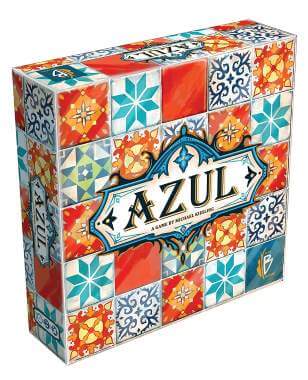
Azul at a Glance
| Game Type Renaissance Theme Abstract Card Drafting Pattern Building Tile Placement | Play Time 30 - 45 mins | Skill/Complexity (2.5 - 5) Good Medium - Light Abstract Strategy |
| Age 8+ | Publisher(s) Plan B Games and Others | Published 2017 |
| Categories Family / Teens / Abstract Strategy | Players 2 - 4 | Manual EN-Azul-Rules PDF |
| Our Rating 9.5/10 | Cost Approx $29.99 |
The goal of Azul, designed by Michael Kiesling, is to achieve the most points by completing the best mosaic on your player board. Players gain points as they place tiles onto their mosaic, but also score at the end of the game for completed vertical and horizontal rows, and for each color that was completely filled in on the board.
The goal of Azul, designed by Michael Kiesling, is to achieve the most points by completing the best mosaic on your player board.
Like Splendor, Azul has very simple turns. Players simply pick one of the circular disks in the middle of the table, and take all the tiles of that color and put it into an available row in the holding area of their player board. The remaining tiles get pushed into the middle of the table. As an alternative, players can take all the tiles of one color from the center of the table.
At the end of the round, players move the right-most tile in each row onto their mosaic provided that row is completely filled (if not, they carry over to the next round). The tricky part about this system is that if a player ever takes more tiles than will fit in a holding row of their board, the excess tiles get placed at the bottom of their board, and the more spaces on the bottom that are filled equate to more negative points at the end of the round.
There’s no question that Azul is a stunning game, both in terms of if visual aesthetics, as well as its simple yet challenging gameplay mechanisms.
Like Splendor, Azul is very easy to teach, and plays quickly enough to the point that it is certainly possible to play multiple rounds in one sitting. Because of these reasons, it serves very well as a game to welcome new players into the hobby and to bring along to family gatherings.
3. Archaeology: The New Expedition – A Fast-Moving Set-Collection Game
One prominent mechanism in Splendor is set collection as players try to accumulate multiple gem cards of the same type in order to attract nobles or acquire cards that provide a large number of victory points. If this is an aspect of Splendor that you enjoy, then Archaeology: The New Expedition is worth looking into as set collection is a significant part of the game.
Designed by Phil Walker Harding, Archaeology: The New Expedition puts players in the role of archaeologists attempting to collect different types of artifacts and sell them to the museum in order to gain the most money by the end of the game. The way players work toward this goal is very simple.
Designed by Phil Walker Harding, Archaeology: The New Expedition puts players in the role of archaeologists attempting to collect different types of artifacts and sell them to the museum.
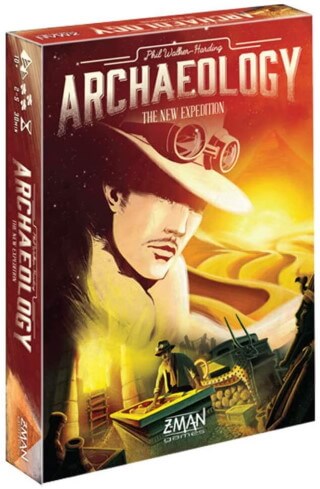
Archaeology: The New Expedition at a Glance
| Game Type Card Drafting, Push Your Luck, Set Collection | Play Time 20 mins | Skill/Complexity (1.5 - 5) Light |
| Age 10+ | Publisher(s) Z-Man Games and others | Published 2016 |
| Categories Family | Players 2 - 5 | Cost $21.99 approx |
| Our Rating 8.7/10 |
On their turn, a player will draw one card from the draw deck, and if it is a treasure card, they add it to their hand. Then, they can perform actions like trading treasure cards from their hand with cards from the public marketplace, selling sets of cards to the museum (and gaining an increasing number of points for larger sets), or exploring a monument (by discarding map cards from their hand to gain additional treasure cards for their hand). If a player draws a thief card, they get to steal a card from another player’s hand. If they draw a sandstorm card, everyone at the table suffers the consequence of losing treasure cards (unless they use their tent card).
If you enjoy the aspect in Splendor of watching what other players are trying to collect in order to try and prevent them from achieving what they are going for, you will likely enjoy that sort of gameplay in Archaeology: The New Expedition. For instance, if you saw a player pick up a rare card on a previous turn from the marketplace, and another card from that set enters the marketplace, you may very well decide to trade some cards from your hand in order to get that card before the other player scores a bunch of points. But then that player might play a thief card and try to take that card from your hand!
Archaeology: The New Expedition is very simple to teach, and it offers a good amount of replayability with many different monuments included in the game (which offer different types of bonuses that players can work toward). It also is very portable, and unlike Splendor, it does not waste any empty box space.
If this game sounds appealing to you, it’s definitely one to pick up and keep in your bag.
4. Biblios – A Small-Box Auctioning Game
An aspect to Splendor’s set collection that many people find exciting is the tension as players try to work toward building up certain types of gems. And if a player is also starting to go for the same thing, do you try to do better than them and beat them to a gem card that’s worth a lot of points, or do you pivot and try working toward something else? If this is something that you enjoy in Splendor, then Bilbios is almost guaranteed to keep you on the edge of your seat for its 20-30 minutes of gameplay.
An aspect to Splendor’s set collection that many people find exciting is the tension as players try to work toward building up certain types of gems.
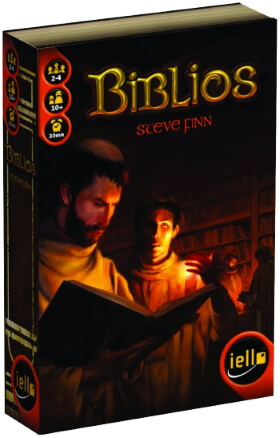
Biblios at a Glance
| Game Type Medieval, Religious, Auction/Bidding, Card Drafting, Commodity Speculation, Hand Management | Play Time 30 mins | Skill/Complexity (1.7 - 5) Light |
| Age 10+ | Publisher(s) Dr. Finn's Games and others | Published 2007 |
| Categories Strategy / Family | Players 2 - 4 (3 is perfect) | Cost $19.95 |
| Our Rating 8.5/10 |
Biblios, designed by Steve Finn, is a quick game that includes card drafting, auctioning, and set collection. In short, players are attempting to get the most points at the end of the game by having the highest-valued sets of different types of books.
An element that’s particularly interesting in this game is that the point value that players receive for any given category of book is able to be manipulated by players throughout the course of the game by playing cards that allow them to do that. This means that at certain times in the game it’s possible you might need to decide to drive down the value of a book category you know you won’t win – or drive up a category you are pretty sure (or hope) you will win.
The game is also divided into two halves. In the first half, players take turns drawing cards, and placing cards either in their personal supply, the auction pile, or public offering. Then, non-active players get to draft cards from the public offering. In other words, all players acquire one card on every person’s turn, making the game have virtually no sense of down-time. In the second half of the game, players take turns flipping cards over from the auction pile and auctioning off the cards.
As is also the case in Splendor, Bilbios will likely leave you wishing that you had just a little more time to collect the kinds of cards you want – and also that you immediately want to start over and play again.
If you are looking for a game to play with friends on a lunch break, it’s really difficult to beat Biblios as a perfect fit for this category.
5. Port Royal – A Push-Your-Luck Pirate-Themed Game
Gamers who enjoy Splendor often enjoy the sense of progression that the game provides. For instance, at the beginning of the game, it can take a few turns of collecting gems to ramp up to a card purchase, but later in the game it’s possible to be able to purchase a card without even discarding gem tokens due to the cards in a player’s display. If this is an aspect of gameplay that you find satisfying, then Port Royal, a light-weight push-your-luck card game, is one that you are very likely to also enjoy.
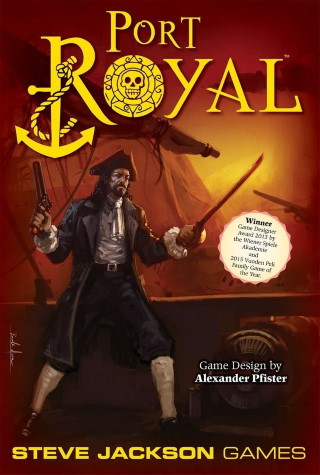
Port Royal at a Glance
| Game Type Nautical & Pirates Theme, Card Drafting, Contracts, Push Your Luck, Set Collection | Play Time 20 - 50 mins | Skill/Complexity (1.7 - 5) Light |
| Age 8+ | Publisher(s) Steve Jackson Games and Others | Published 2014 |
| Categories Family | Players 2 - 5 | Cost $19.99 approx. |
| Our Rating 8.6/10 |
Port Royal is designed by versatile game designer Alexander Pfister, known for both his heavy Euro-games like Great Western Trail and Mombasa, as well as his smaller box card games like this one and Oh My Goods!.
In Port Royal, players take turns flipping over cards face-up into a public display until they either bust by drawing two pirate cards of the same color, or decide to stop. If they stop, they then take a single card from the public display, followed by every other player in clockwise order. When an active player takes a card, they either gain money (if it is a pirate card), or pay money (if it is a person card). Person cards remain in a player’s tableau until the end of the game and provide both victory points and ongoing abilities. When players other than the active player take a card, they must pay the active player 1 coin in, as well as pay to the bank any cost requirements listed on the card.
Person cards provide a light engine-building element to the game. For instance, they can provide extra money when pirate ships of certain colors are drawn, or when a certain number of cards are available in the public display. They can also help players to fight off pirate ships (in order to avoid busting), or to complete requirements for expeditions in order to gain victory points.
Person cards provide a light engine-building element to the game. For instance, they can provide extra money when pirate ships of certain colors are drawn, or when a certain number of cards are available in the public display.
This engine-building element, while very light, certainly provides a sense of ramping up in the game, as it makes it much easier to gain money and to do what you want on your turn. They can also change up the way you play; for example, if a card incentivizes you to have a lot of cards in the public display, you are more likely to want to draw more cards and push your luck (and to egg other players on to keep drawing as well).
Like Splendor, Port Royal is a lot of fun, and works really well as a filler game and one to introduce family members to who may not play many games.
6. San Juan – An Engine-Building Card Game
If you enjoy everything that Splendor has to offer, but it leaves you wishing that there was just a little more in terms of strategic decisions and depth, San Juan, designed by Andreas Seyfarth, is a card game that plays in about the same amount of time but adds just enough strategic depth to satisfy the inner-gamer in you.
San Juan, designed by Andreas Seyfarth, is a card game that plays in about the same amount of time but adds just enough strategic depth to satisfy the inner-gamer in you.
Based on the classic game Puerto Rico, San Juan is a game that takes classic Euro-game mechanisms and pulls them into a game with very simple components: a deck of cards, and some tiles. Yet, it’s a game that is so well-designed that it won’t leave you feeling like it’s any “less” of a game than some other big-box games.
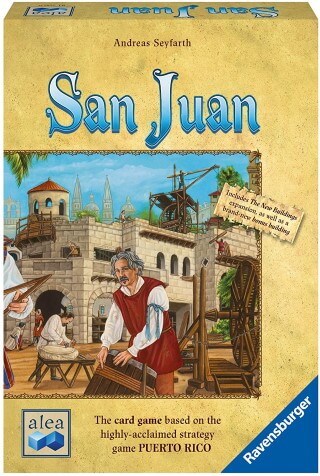
San Juan at a Glance
| Game Type City Building, Economic, Action Drafting, Hand Management, Set Collection, Variable Phase Order | Play Time 45 - 60 mins | Skill/Complexity (2.3 - 5) Light - Medium |
| Age 10+ | Publisher(s) Ravensburger and Others | Published 2004 |
| Categories Strategy / Family | Players 2 - 4 | Cost $34.99 approx. |
| Our Rating 8.9/10 |
In San Juan, players are trying to gain the most victory points by adding buildings and plantations into their tableau in order to provide ongoing benefits, end-game scoring bonuses, and resource production.
San Juan is an action-selection game in which players, on their turn, select a certain role which triggers a particular action. All players get to perform that same action, but the player who selected it gets an added benefit; for instance, when a player chooses the Builder, all players get to build a building, but the person who selected it gets to pay 1 less.
A very interesting part of the game, and one that lends itself to some difficult decisions, is the fact that cards in a player’s hand act as currency in the game. In other words, when a player wishes to build a card from their hand into their tableau, they must discard a certain number of cards as indicated on the one they wish to build.
Another aspect that fans of Splendor will appreciate is the fact that San Juan rewards players for paying attention to what other players are doing. If you notice, for instance, that a player has no money, it could be a good time to select the Builder role as they will not be able to benefit from that action.
With many different strategic angles players can take in San Juan, along with its smooth gameplay, this game is one that is easy to play hundreds of times and never get tired of. It’s very quick to set up, and is relatively easy to explain to new players. It is slightly more complex in terms of decision space as Splendor, making it a good “next-step” game if that is what you are looking for.
7. Imhotep – A Spiel des Jahres Nominee
Splendor is known for being a go-to family-weight board game. If you are looking for another game in this same category, a good place to look is at a list of games that have been nominated for the Spiel des Jahres award, which focuses on recognizing games that are particularly welcoming to players who are new to gaming with relatively simple rules and quick turns. One of these games that is worth checking out is Imhotep, designed by Phil Walker Harding.
Imhotep is a game that is both extremely simple in its rules, but very challenging to do well as it requires some spacial planning and a little bit of trying to out-guess and outsmart other players at the table as well.
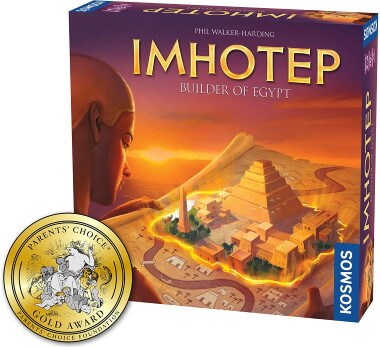
Imhotep at a Glance
| Game Type Ancient Theme, End Game Bonuses, Modular Board, Set Collection, Worker Placement | Play Time 40 mins | Skill/Complexity (2 - 5) Light - Medium |
| Age 10+ | Publisher(s) KOSMOS and Others | Published 2016 |
| Categories Strategy / Family | Players 2 - 4 | Cost $34.99 approx. |
| Our Rating 9/10 |
The goal of Imhotep is to gain the most points after six set rounds, and the main idea is that players take on the role of builders in Egypt as they try to best contribute to building structures and monuments. They do so by loading stones of their player color onto ships, which can be shared amongst players, and then sending those ships to different sites where the stones will be unloaded in order and used at that particular site.
The goal of Imhotep is to gain the most points after six set rounds, and the main idea is that players take on the role of builders in Egypt as they try to best contribute to building structures and monuments.
A player’s turn in Imhotep is very simple. They can: gather more stones, place a stone on an available space on a ship, sail a ship (which meets the requirement), or play an action card from their hand. Ships have various levels of capacity for stones, and multiple players can have stones on a ship. When a player places a stone on a ship, they may place it on any available space. When a ship is sailed, it must dock at an available site (i.e., a site which has not yet been accessed in the current round), and then stones are unloaded from front to back.
Sites include building a pyramid, an obelisk, a burial chamber, and gathering action cards, and the specific spot where a stone is placed at a site can provide different amounts of points, or different types of benefits. While players can decide where to place a stone on a ship, any player can sail that ship and place it where they would like, meaning that a player may have no control over where the stone ends up at a particular site. This can provide a great deal of tension as players try to position themselves well for the most points at a particular site, or first-pick at action cards – but only if the ship sails to the place that they want.
Because Imhotep has such simple rules and quick turns, yet offers a challenge in terms of trying to get your stones to the right place at the right time, it is a very fun and engaging game in which you’ll constantly be paying attention to other players at the table and trying to guess what they are trying to do. When sailing a ship, you’ll try to strategically dock the ship at a spot that will benefit you the most, and provide minimal benefits to other players on the ship. If this sounds appealing to you, Imhotep is very worthy of your time and it’s a blast to play.
8. Barenpark – A Polyomino Tile-Placement Game
Barenpark is the 3rd game designed by Phil Walker Harding to appear on this list, but it should come as no surprise since he is known for making games that, like Splendor, are easy to learn, while still providing many fun and interesting decisions.
Out of all the games on this list, if you are looking for a game that is the simplest in terms of teaching and learning, then Barenpark wins hands-down in that category.
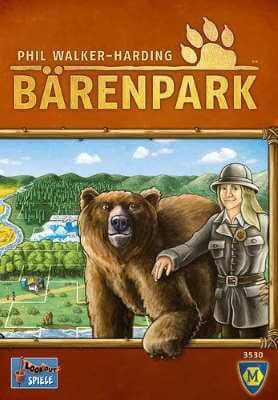
Bärenpark at a Glance
| Game Type Animals Theme, Puzzle, Card Drafting, Grid Coverage, Set Collection, Tile Placement | Play Time 30 - 45 mins | Skill/Complexity (1.8 - 5) Light |
| Age 8+ | Publisher(s) Lookout Spiele, Asmodee | Published 2017 |
| Categories Family | Players 2 - 4 | Cost $39.99 |
| Our Rating 9/10 |
In Barenpark, players are attempting to gain the most points by building the best bear park. They do so by filling in (mostly) empty player boards with polyomino-shaped tiles from a public display. Points in the game come from the tiles themselves (different tiles have different amounts of victory points), bear statues (which are awarded when a player completes a player board), as well as from randomized scoring objectives.
In Barenpark, players are attempting to gain the most points by building the best bear park. They do so by filling in (mostly) empty player boards with polyomino-shaped tiles…
As mentioned above, teaching and learning this game is dead simple. On a player’s turn, they place a tile from their supply onto their board, and then, depending on icons that they cover with that tile, they will be able to take additional tiles from the public display, or grab an additional player board to add to their park. The game is over once a player has completed 4 player boards, at which point the winner is determined by the most victory points.
Another aspect that fans of Splendor will appreciate is the bonus scoring objectives that all players have access to, which help to guide the sorts of strategic decisions players make throughout the course of the game. This is similar to the noble tiles in Splendor, with the exception that more than one player can score a bonus objective in Barenpark, but the first player to complete it receives the most points.
Because Barenpark is a game that you can teach to just about anybody, and provides a decent amount of fun with trying to puzzle together an interesting-looking bear park, as well as trying to complete some bonus objectives, it’s definitely worth a try.
9. Bob Ross: Art of Chill – Will You Reach Ultimate Chill Status?
Recently there have been many IP-based games entering the hobby board game space, and it’s easy to be apprehensive about whether these games will actually be any good. At first glance, Bob Ross: Art of Chill seems simply too good to be true. A board game…about painting happy little trees and making happy accidents? Could it possibly be any good? The answer is surprisingly – yes, it is.
A board game…about painting happy little trees and making happy accidents? Could it possibly be any good? The answer is surprisingly – yes, it is.

Bob Ross: Art of Chill at a Glance
| Game Type TV Theme, Action Points, Card Drafting, Dice Rolling, Hand Management, Set Collection | Play Time 30 mins | Skill/Complexity (1.8 - 5) Light - Medium |
| Age 12+ | Publisher(s) Big G Creative | Published 2017 |
| Categories Family | Players 2 - 4 | Cost $23.99 approx. |
| Our Rating 7.4/10 |
Bob Ross: Art of Chill is a game that has a very similar feel and flow to Splendor. It’s about collecting cards of different colors and playing those cards into your paint palette, and then using colors from your palette to paint different features on a painting in order to score points.
There is also some very light engine-building in the sense that players can collect technique cards in order to gain extra points when they complete paintings containing particular colors or tools. Ultimately, the fist player to reach the Chill space on the Chill Meter wins the game, but as the rulebook states, “you’re playing a Bob Ross game, so really…Everyone’s a winner!.”
While Bob Ross: Art of Chill has a similar feel to Splendor, and is just as much fun, it may actually be slightly easier to teach in the sense that the theme really works in its favor.
The mechanisms in this game, for the most part, do make sense thematically, and people who are fans of Bob Ross are going to absolutely love the references to the TV show used throughout the game.
If this sounds like fun to you, grab your paint brush and palette and get ready to enter the chill zone.
10. Kashgar: Merchants of the Silk Road – A Unique Take on Deck-Building
A simple resource-management system is a prevalent aspect of Spendor, as players try and focus on collecting certain types of gems in order to have the right requirements to purchase certain cards or receive visits from nobles – to ultimately gain victory points.
Kashgar: Merchants of the Silk Road is another game with simple resource-management mechanisms that provides a similar feel of constantly gaining and spending resources to purchase items in order to gain points, but Kashgar adds a layer of deck building and management.
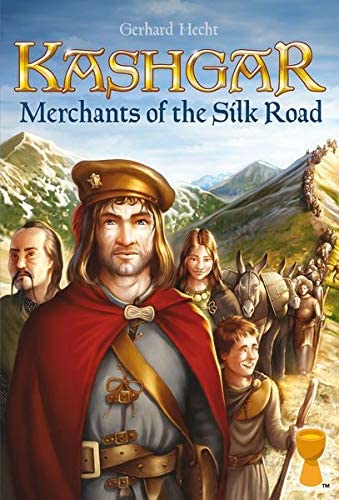
Kashgar: Merchants of the Silk Road at a Glance
| Game Type Card Game, Economic Contracts, Deck Building | Play Time 45 mins | Skill/Complexity (2.4 - 5) Light - Medium |
| Age 12+ | Publisher(s) KOSMOS, Grail Games | Published 2013 |
| Categories Strategy | Players 2 - 4 | Cost $39.95 approx. |
| Our Rating 7.7/10 |
In Kashgar: Mechants of the Silk Road, designed by Gerhard Hecht, players take on the role of caravan leaders on the silk road, and must manage three caravans in order to attempt to gain the most victory points. The game has a deck-building mechanism similar to games like Dominion, but with a unique twist that players manage three different decks, and those decks are always face up and never shuffled; in other words, players continuously cycle through their three decks in the same order.
The game has a deck-building mechanism similar to games like Dominion, but with a unique twist that players manage three different decks……..
These decks represent a player’s caravans, and begin with one single card, but over the course of the game can grow to contain many cards. The cards in a caravan are always displayed in a way where the top portion of each card in the stack is visible to the player at all times. Turns in this game are very simple: players select the top card in one of their three caravans, move it to the back of the caravan, and activate its action. Meanwhile, players keep track of their resources (such as spices, donkeys, and gold) on a player resource-tracker board.
Certain cards allow players to perform certain types of actions, such as fulfilling contracts and gaining additional cards into their caravan. Both cards and contracts provide points, and once any player has reached 25 points, the game ends with the current round, and whoever has the most points is the winner of the game.
Fans of Splendor will definitely appreciate the simplicity of rules and turn structure in this game. There aren’t many rules to keep track of in the sense that you select one card on your turn and simply do what it says. Yet, the aspect of trying to manage the three caravans efficiently and time turns in a way that allows you to make powerful turns can be a very difficult challenge, and due to the different types of cards included in the game and luck-of-the-draw, players will continue to be presented with interesting decisions.
If you enjoy Splendor, and also enjoy deck-building games, Kashgar is definitely a game to put on your radar.
That’s about it for the Best Games Like to Splendor – Top 10 That Are Similar category for now!

